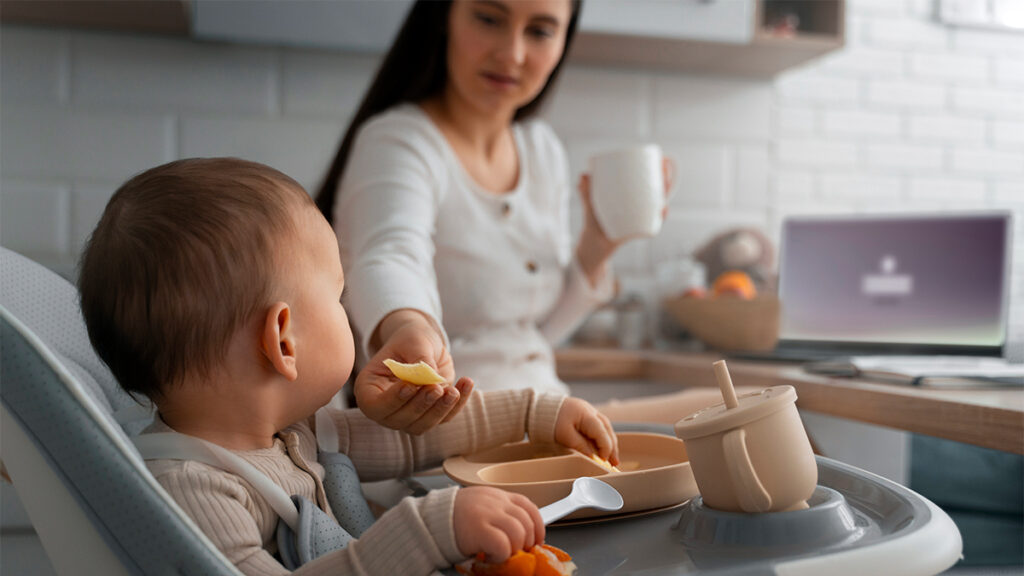Weaning your baby can feel like a huge step, and let’s be honest, it can be a little overwhelming with all the different advice out there. But don’t stress. This guide is packed with tips based on research, clears up some common myths, and will help you create a weaning plan that works for both you and your baby.
So, What’s Baby Weaning All About?
Baby weaning is the process of slowly replacing breastfeeding with solid foods. It’s a natural part of your baby’s development, and it helps them grow in a healthy way.
- It typically starts around 6 months, when babies are ready for solids.
- It’s a gradual process—sometimes it can take months or even years, depending on your baby’s needs.
- Weaning isn’t just about introducing solids; it’s also a chance for your baby to explore new tastes and textures!
When Should You Start Baby Weaning?
The exact timing really depends on your baby. Every little one is different, so it’s important to pay attention to their cues.
How Do You Know When Your Baby’s Ready?
- They can sit up on their own and hold their head steady.
- They show interest in food—reaching for your plate or watching you eat.
- They can swallow food without spitting it out (this is key).
What Do the Experts Say?
American Academy of Pediatrics (AAP): They say the same—breastfeed exclusively for 6 months and keep breastfeeding for at least the first year.
World Health Organization (WHO): They recommend breastfeeding exclusively for the first 6 months and then continuing to breastfeed while introducing solids for at least two years.
Busting Common Baby Weaning Myths
There are so many myths about weaning that can leave you feeling confused. Let’s set the record straight.
- Myth 1: Babies should stop breastfeeding by 6 months.
- Truth: Extended breastfeeding is totally okay and actually beneficial for your baby’s health.
- Myth 2: Breastfeeding too long can spoil kids.
- Truth: Longer breastfeeding promotes emotional security and a stronger immune system.
- Myth 3: Weaning needs to be abrupt.
- Truth: A gradual approach to weaning is less stressful for both you and your baby.
Different Ways to Approach Baby Weaning
There’s no one-size-fits-all here. The way you wean will depend on your family’s needs and how ready your baby is.
1. Child-Led Weaning (Natural Weaning)
In this method, your baby slowly loses interest in breastfeeding on their own. It’s a gradual process, and it can take months or even years.
2. Planned Weaning
With planned weaning, you take the lead and decide which feedings to skip. You might start with weaning during the day and slowly move to nighttime weaning.
What Is Baby Weaning (BLW)?
Baby-led weaning is all about giving your baby the chance to feed themselves from the get-go. Instead of spoon-feeding purees, you let your baby explore solids on their own, which helps with developing motor skills and learning about different textures and flavors.
Key Things to Know About Baby Weaning:
- When to Start: Wait until your baby is around 6 months and can sit up and grasp things.
- Safety First: Always supervise your baby while they’re eating. Cut food into appropriate sizes to avoid choking hazards.
- Balance Their Diet: Make sure your baby is getting all the nutrients they need—think protein, healthy fats, iron, and vitamins.
Best Baby-Led Weaning Foods:
Here’s a breakdown of the best foods to introduce by category:
Fruits:
Soft fruits like bananas, avocado, and mango.
Cooked fruits such as steamed apples and pears.
Veggies:
Roasted or steamed veggies like sweet potatoes, carrots, and broccoli.
Raw veggies for older babies, like cucumber sticks or cherry tomatoes.
Proteins:
Soft meats like shredded chicken, turkey, and flaked salmon.
Eggs: scrambled or hard-boiled.
Plant-based foods like cooked lentils, chickpeas, or tofu.
Dairy:
Soft cheeses like mozzarella or cheddar.
Plain, full-fat yogurt.
Carbs:
Whole grain toast, rice cakes, or pasta.
Mashed potatoes or roasted potato chunks.
Healthy Snacks:
Mini pancakes, waffles, or oatmeal fingers.
- Family Resistance: Share trusted resources like WHO or AAP guidelines to educate others who may not understand your choice.
The Benefits of Extended Breastfeeding
Breastfeeding beyond 6 months offers some pretty great benefits:
- Strengthens your baby’s immune system.
- Provides emotional comfort during stressful times.
- Reduces the risk of allergies and illnesses.
Transitioning from Breast to Cup
Eventually, you’ll want to switch from breast to a cup. Here’s how:
- Start introducing a sippy cup around 6–9 months.
- Gradually replace breastfeeding sessions with cup feedings, especially during the day.
Handling Criticism About Weaning
Choosing how long to breastfeed is personal. If others criticize your decision, here’s how to respond:
- “The WHO recommends breastfeeding for at least two years.”
- “Breastfeeding is incredibly beneficial for both me and my baby.”
If you’re ever unsure, your pediatrician is the best person to turn to for advice.
Frequently Asked Questions (FAQs) on Baby Weaning
- Q: How do I know when my baby is ready to wean?
- A: Baby Weaning Look for signs like sitting up on their own, showing interest in food, and swallowing solids.
- Q: Can I breastfeed and offer solids at the same time?
- A: Absolutely! Complementary feeding works great alongside breastfeeding.
- Q: How long does the weaning process take?
- A: It varies. Some babies wean quickly, while others take longer. It’s all about what feels right for you and your baby.
Baby weaning is a unique and personal journey for every family. Whether you go for a baby-led approach or a more planned one, the most important thing is to follow your baby’s cues and make it a positive experience. With some patience and these helpful tips, you’ll be able to navigate weaning smoothly, knowing you’re giving your baby the best start.
Read also: Baby Shower Planning

